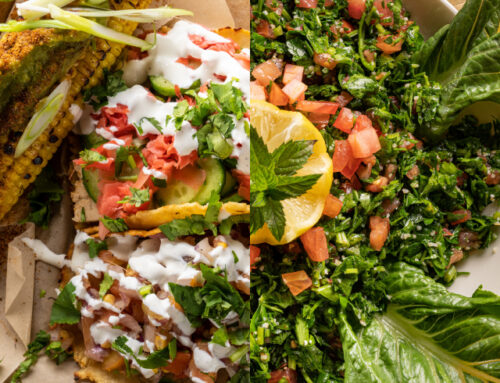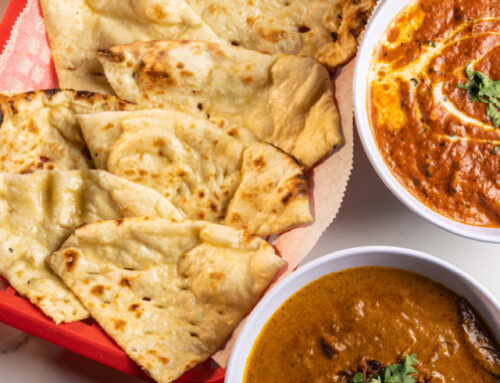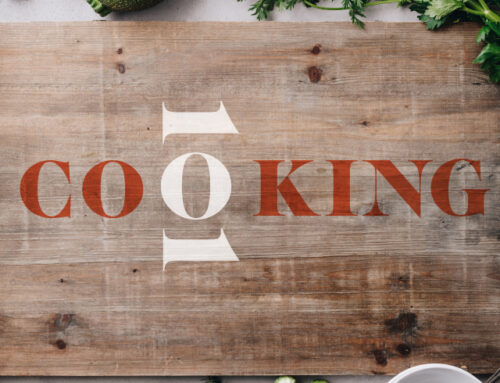The Cutting Edge
by Lenora Dannelke
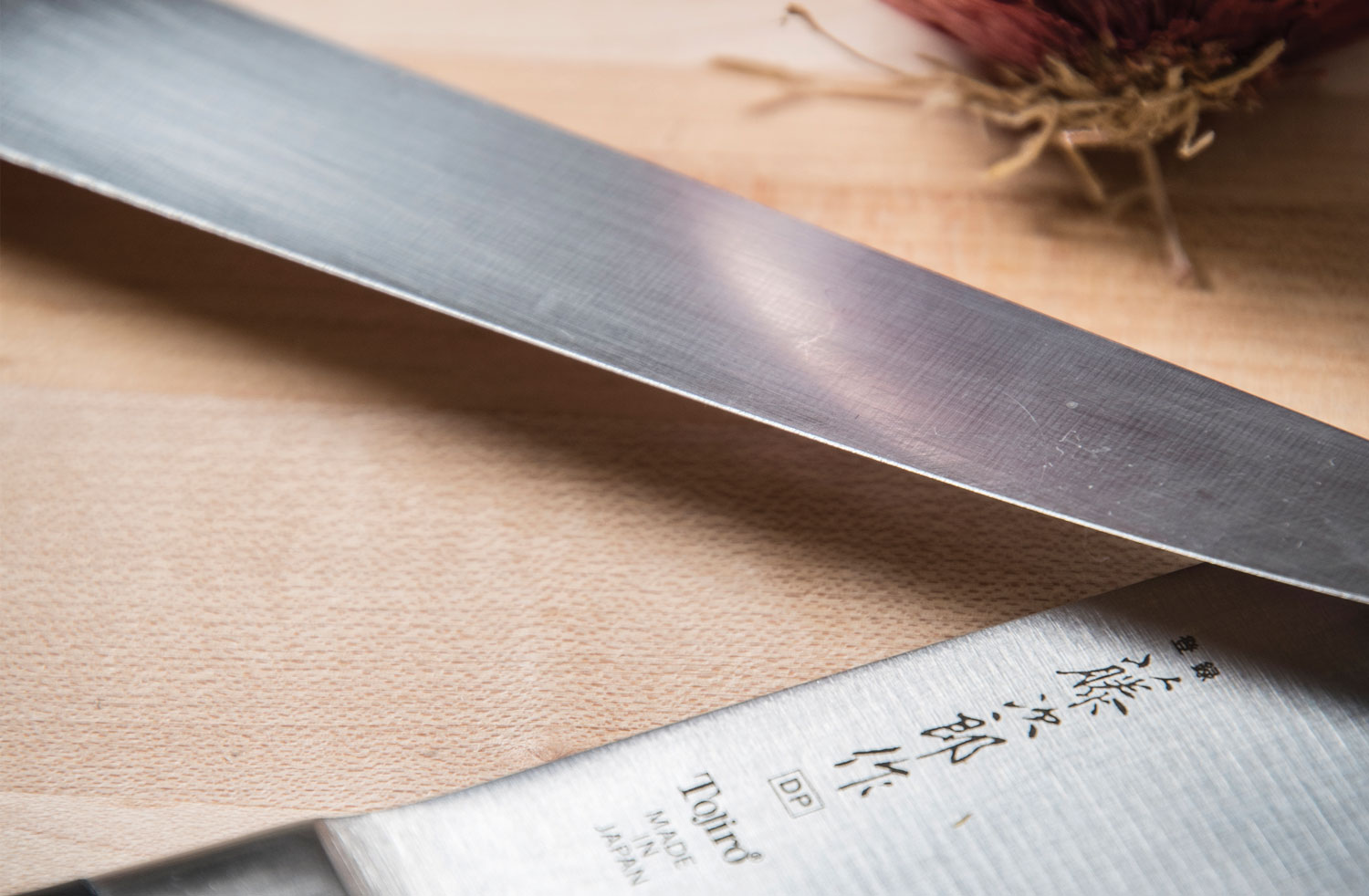
A spectrum of social media platforms enables people to connect with their perfect partner. Unfortunately, when it comes to the paramount culinary relationship in life—the one between cook and knife, a bond that can endure for decades—you’re pretty much on your own to find the right match
An overwhelming abundance of information and choices available online and in stores can drive many a confused consumer to make dubious choices.
Why, you might think, should anyone spring $50 to $100 (or much more) on one chef knife when discount stores offer spiffy-looking 15-piece sets, complete with a butcher block, for less than twenty bucks? These bargains, however, fail to deliver the strength and durability needed to keep you slicing and dicing into your sunset years. In fact, culinary professionals who shared their knowledge for this article generally recommend taking a piecemeal approach to building a knife collection suited to individual needs.
“Knives are as important in the kitchen as you are,” says Nancy O’Keefe, owner of La Belle Cuisine, a fine cookware shop in Emmaus that specializes in German-made Messermeister cutlery. “It’s like anything in this store, if you buy it once and take care of it, it will last you a lifetime. Your kids will fight over these things when you’re gone.” (Of course, you can avoid familial knife-fights by gifting each child a good chef knife as a rite-of-passage into adulthood.)
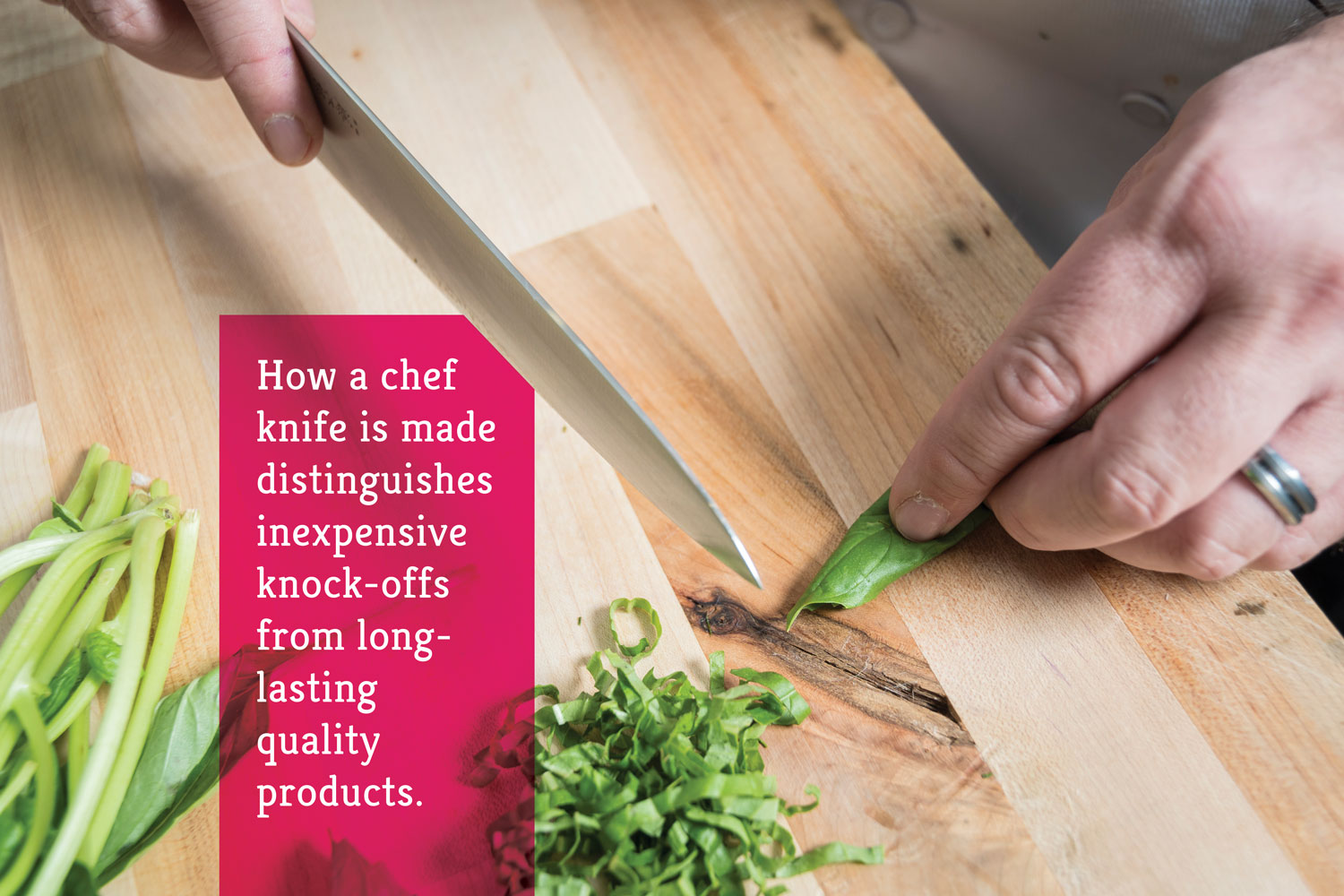
WHAT MAKES A KNIFE A CUT ABOVE
Most German knives are made of stainless steel with a high-carbon content. This blend that melds the best qualities of both metals: High carbon steel holds an edge well but can stain, rust, and turn black; stainless steel looks great but is harder to sharpen. Each maker possesses a trade-secret recipe for a steel mixture that can include cobalt, manganese, chromium, nickel, and other alloys that are of interest only if your hobby is metallurgy.
How a chef knife is made distinguishes inexpensive knock-offs from long-lasting quality products. A stamped knife is created cookie-cutter style from a large sheet of steel, to which a handle is attached. In contrast, a forged knife is heated and shaped from a single bar of steel. In the stamped version, the tang—the unsharpened continuation of the blade metal—may run only partway through the handle (called a partial tang), making the attachment less secure and prone to breakage.
Forged knives always boast a full tang that continues to the end of the handle, creating better weight and balance for easier use. In addition, they feature a bolster, which is the thicker, shoulder-like part where blade and handle meet. (The bolster assists in effecting a comfortable, high-control pinch grip, where the bent index finger touches the blade, the remaining fingers are wrapped around the handle, and the thumb rests on the blade.) Stamped knives,
in contrast, never have a bolster.
Chef knives are made from 8 to 12 inches in length to accommodate different tasks—extra length translates to extra leverage—and different sized hands.
You may wonder whether divots on the blades of many Santuko knives, and more recently chef knives, are decorative or functional. In fact, these indentations create tiny air pockets that reduce friction and help prevent food from suctioning to the blade.
“I like them because when you’re cutting a protein, which can stick to a regular blade, it will fall off. So you’re cutting as fast as you can,” says Chef Shawn Doyle. To further reduce food adhesion, some blades are made with a series of holes. These, however, he cautions against, as they offer places for food particles to hide and bacteria to grow.

Sharp Insights
from Erin Murphy, Executive Chef
Addressing the specific needs of the distaff side of the home cooking team, Erin says, “A lot of chef knives are built for men and that has been an industry standard for years. Professional chefs tend to be male. That’s something that over the years I’ve struggled with as a female chef: finding the right knife. It’s something you need to do your research on and try. My biggest piece of advice for women is to get a smaller chef knife that’s not too long. It’s easier for our hands to grasp the tang. If it’s too big and not weighted right, it ends up hurting your wrist. A smaller chef knife is easier to work with and handle.” The must-haves used in her home kitchen include just a chef knife and paring knife. “You need a small knife to hold in your hand, to peel a potato, to do finer cuts on different fruits, to be able to break down mushroom stems. It’s a handheld knife; the chef knife is a cutting board knife.”
As a minimalist who hates a cluttered kitchen, this chef sticks with the essentials for day-to-day use.
CUTLERY CARE & MAINTENANCE
A two-part process of maintaining the edge on a knife blade involves honing and sharpening, which many people mistakenly believe are synonymous. A honing steel, a metal rod with a handle, actually pushes the edge back into center alignment as the blade is run against it from the blade heel (bottom) to point (top), providing a sharper edge without removing any metal. (The microscopic bending or folding of the edge that occurs from normal use isn’t visible to the naked eye, so don’t wait until you see a problem.) Sharpening, on the other hand, grinds away metal to form a new edge. Both are vital functions in keeping an all-important edge, and not just for performance.“If you have a dull knife, it’s actually very dangerous. The potential to cut yourself is greater and more accidents are going to happen,” says Chef Christopher Heath, who believes that education is a big part of cooking. “Any time chefs pick up their knives, they have a sharpening steel with them—not just at Thanksgiving. When I was growing up, the only time I saw the sharpening steel out was for Thanksgiving turkey. As a home cook, you should put your knife on a steel every time you pick it up. If you do that continuously and honing the blade becomes habit, it will stay sharper longer.”
He also advocates for getting kids involved in kitchen activities. Youngsters too little to handle knives will still learn from observation!
Well-honed knives need to be sharpened only once or twice a year, so skip purchasing electric knife sharpeners. And definitely don’t fall for the hand-held gadgets that can actually inflict damage on a blade.
Do-it-yourself-ers who want to try manual sharpening with a whetstone—a natural or artificial stone with a fine-grit surface—should make that an in-store purchase and ask for instructions. However, when it comes to electric sharpening, Chef Erin Murphy says, “Leave it to the professionals.”
(Note: Williams-Sonoma reports that they will sharpen your first knife for free, with a $5 charge for each additional knife—which is a great bargain.)
Serrated knives, unfortunately, can’t be sharpened. “Victorinox brand bread knives are only $20 to $25 and they last for years. Then you throw it out and get a new one,” says Chef Jason Hook.
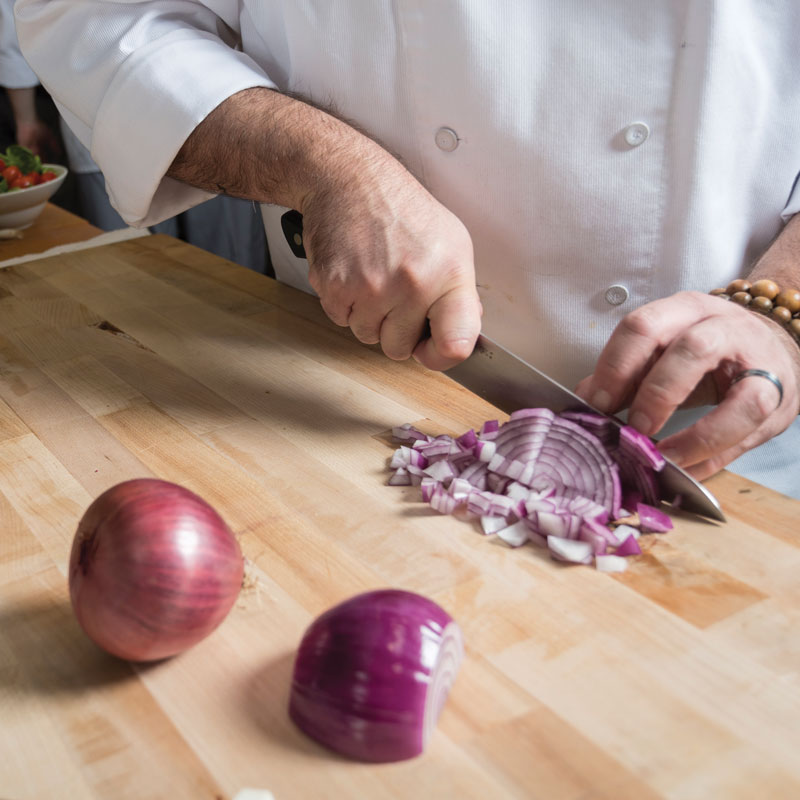
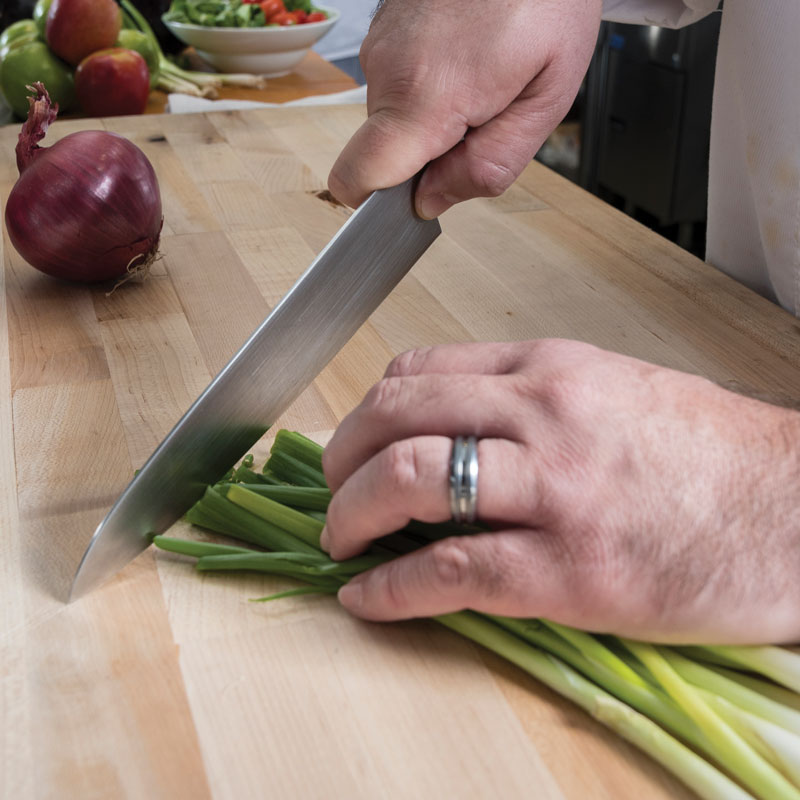
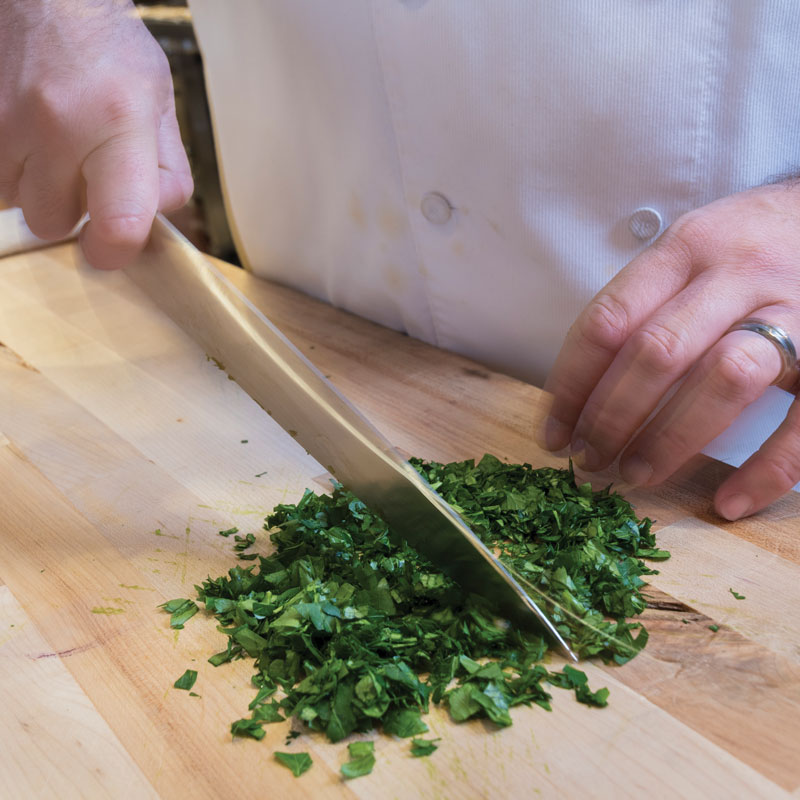
KNIFE USE & MISUSE
The necessary partner to a knife is a wood cutting board: Chopping that onion on a countertop is doing a disservice to the blade and counter surface. Wood is soft enough to not dull a blade, while bamboo—though attractive and currently popular—is actually harder than wood and will cause more wear on knives. And consider having a supplemental plastic cutting board for specific jobs. “What I tell home chefs is that a wood cutting board is for vegetables and a thick plastic cutting board is for meat. The plastic ones come in play for cross-contamination issues—you don’t want to chop up chicken on your wood cutting board then cut up some mushrooms,” says Chef Erin, who avoids cutting foods that will stain on a wood board. “When I’m cooking beets, I’m going to do that on a plastic one. It’s cheaper and easier to clean and can be thrown away if you don’t want it anymore.”
Regardless of the type of board, Chef Erin always puts a damp tea towel between the board and counter to keep it from moving. “You want stability when you’re cutting.” She further adds that she would never use a glass cutting board. “They slip, they slide, and you can wind up chopping a finger off.”
Transferring food from the board to a bowl or pan should be done with a bench scraper, a rectangular piece of metal with a handle on top, not the knife blade. Tempting as it is to simply scoop up a pile of minced garlic with that nice wide-bladed knife in your hand, the damage inflicted on the edge by running it across the board is tantamount to knife abuse. And a bench scraper can be used for other tasks, such as cutting dough.
They usually come in a 6-inch length with measurements marked along the edge—making this an ideal tool for preparing the Ricotta Gnocchi on page 138.
(If you choose to ignore this suggestion, at least turn the knife over and scoop with the unsharpened spine instead of the blade.)
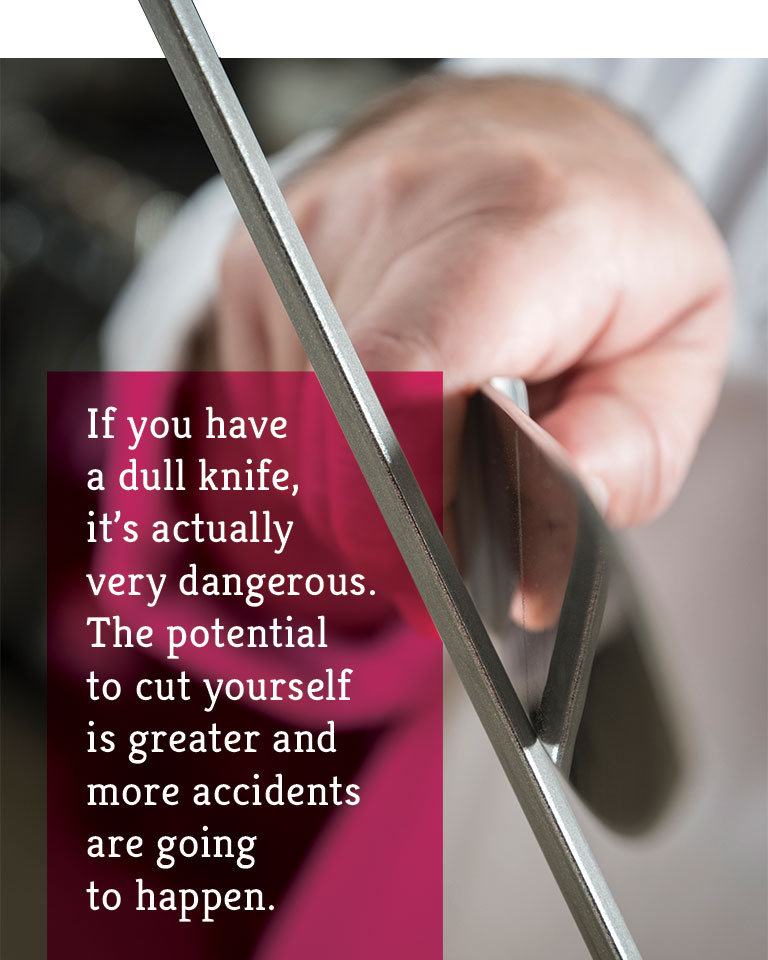

Sharp Insights
From Shawn Doyle, Chef/Owner, The Savory Grille
Chef Shawn says that a knife is not only “my tool, it’s an extension of my hand.” He also reports that “everyone in my kitchen has their own set of knives.” After all, the choices are highly personal, driven not only by performance but by comfort.When Shawn started his career, heavier German knives were the go-to tools of professionals. However, his favorites have expanded to include lighter-weight Japanese knives. “Even an ounce can make a difference when you spend an hour cutting vegetables.” The Santoku—translating to “three virtues,” or “three cuts,” i.e., slicing, dicing, and mincing—is a style of knife rather than a brand, and is also made by Western manufacturers. A straight blade, which differs from a chef knife with a curved end that accommodates a rocking motion on the cutting surface, requires some practice to use—so make this a later addition to your collection.
Shawn recommends researching knives online before going to a store. “Touch the knives,” he says. “If it doesn’t fit your hand right, it’s not going to be balanced and it’s going to be uncomfortable.” His four essentials for the home kitchen include a chef knife, a boning knife, a bread knife, and a paring knife.
POINTED TIPS
DO
Do wash knives in warm (not hot) soapy water after each use, using a soft sponge—not a scrubby—and dry immediately, preferably with a paper towel. A damp knife can breed bacteria, especially when stowed in a butcher block.
DON’T
Don’t put knives in the dishwasher. Banging against utensils and dishware can ding the edge, and the temperature of the drying cycle may be high enough to warp the blade.
DO
Do store knives properly, whether a butcher block, magnetic strip, or other type of storage. Throwing an unprotected knife in a drawer can hurt the blade, and there’s a chance it will hurt you when reaching in to grab something.
DON’T
Don’t use a knife to pry open anything, ever. Just don’t.
Sharp Insights
From Christopher Heath, Corporate Chef, Paxos Restaurants
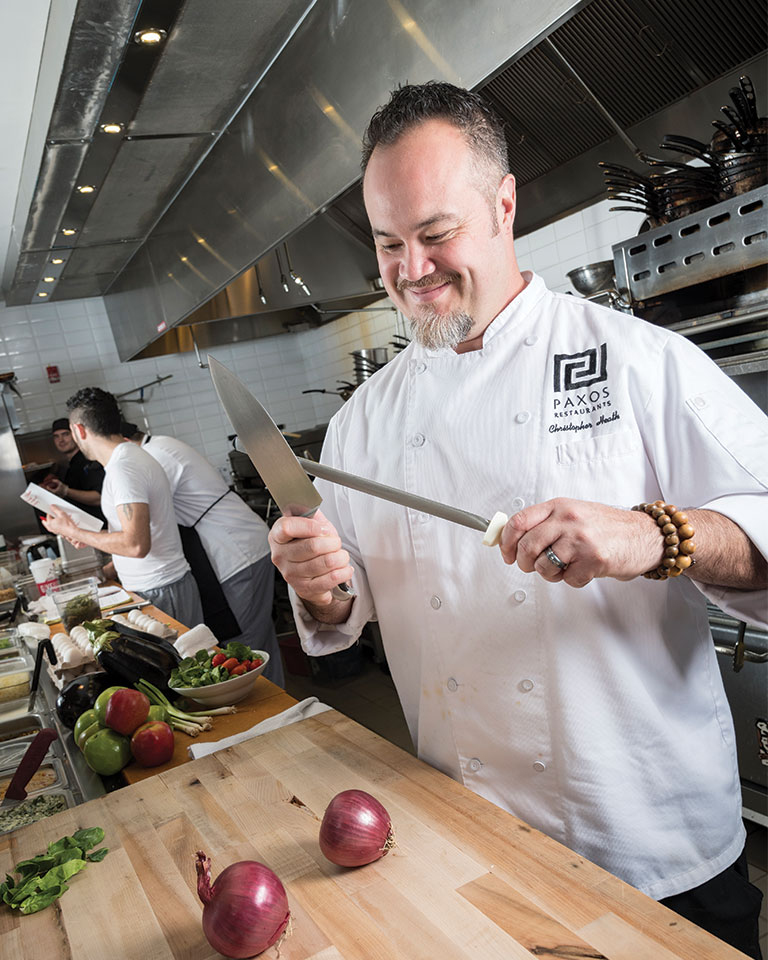
Ask about the differences between the knife-needs of home cooks and pros and Christopher responds, “Personally, I don’t see a difference. To be serious about cooking at home, it starts with a great knife. A carpenter has a hammer; a cook has a knife.” Some of his favorite German knives for work and at home include a Wüsthof Classic—“It’s a great, durable, sharp knife. As long as you take care of it, it will last forever”—and a Gunter Wilhelm—“That’s another heavy-duty, tough knife.” A Western-style Japanese knife by Torijo, with a thinner blade that translates to extraordinary sharpness, is another top choice. For working with proteins, he chooses Italian boning knives by Sanelli to butcher fish, fabricate meat, and cut poultry. Though ceramic knives have become trendy, he considers them a fad and dislikes the delicate nature of the blade. “I’ve seen too many of them shatter and I don’t want them around food. If you accidentally drop it to the counter from your hand, it can break. I truly believe that at the very least, a home cook should have one incredible German knife.”He recommends that an 8-inch chef knife be a cook’s first knife, which can be used “all day long” for virtually any cutting job.
As seen in the Summer/Fall 2022 Issue
Click to Visit Our Advertisers

